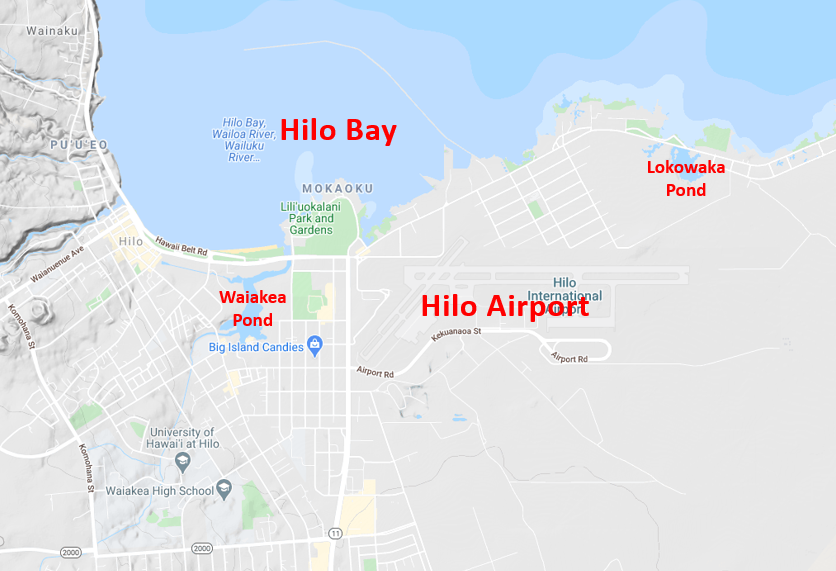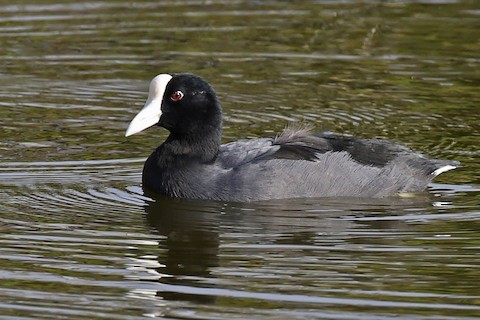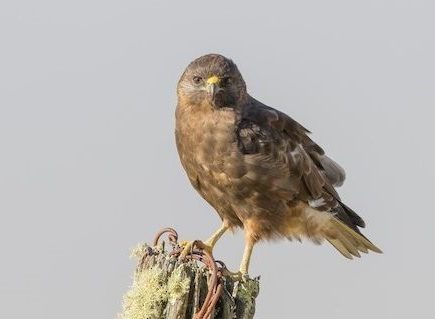Wailoa River State Park, Big Island, Hawaii

Hilo’s airport sits between two large ponds that attract a diverse mix of migratory waterfowl and other aquatic birds, especially in fall and winter. Waiakea Pond is an estuary at the center of the town’s main greenspace, Wailoa River State Park, and Lokowaka Pond is an attractive seaside lagoon on the eastern outskirts. Hawaiian Goose is common year-round at Waiakea Pond, a few Hawaiian Coots are typically present at both, and Hawaiian Hawk is sporadic throughout the area.
Orientation
Directions
Wailoa River State Park (Waiakea Pond) occupies much of central Hilo. Lokowaka Pond is two miles east.
From Hilo International Airport. Turn right (north) onto Kanoelehua Avenue, go 0.3 miles, and turn left (west) onto Piilani Street, which goes six blocks and ends at Wailoa River State Park’s extensive parking lots beside Waiakea Pond.
To get to Lokowaka Pond, continue north on Kanoelehua Avenue for another 0.4 miles, turn right onto Kamehameha Avenue, then immediately fork left onto Kalanianaole Avenue, which reaches Lokowaka Pond after about 2.0 miles.

Birdfinding
Hilo has two productive ponds. In the town center, west of the airport is Waiakea Pond, and east of the airport is Lokowaka Pond. Both are principally known for waterbirds, including a few native species and a long list of regular migrants and irregular vagrants.
Waiakea Pond. Wailoa River State Park consists mainly of Waiakea Pond, surrounded by expanses of lawns, ornamental gardens, and woodlots. There are paths all around the pond, connected by footbridges that cross a narrow stretch in the middle via a small island.

Flocks of Hawaiian Goose are usually in evidence in the pond and on the adjacent lawns. Hawaiian Coot is not always numerous, but can usually be found. Other regularly occurring species include: Pied-billed Grebe, Pacific Golden-Plover, Ruddy Turnstone, Wandering Tattler, Black-crowned Night-Heron, Western Cattle Egret, Hawaiian Hawk, Common Waxbill, Scaly-breasted Munia, Java Sparrow, Yellow-fronted Canary, Yellow-billed Cardinal, Saffron Finch.
Rarities have included: Garganey, Tufted Duck, Snowy Egret, White-faced Ibis, Osprey, and Belted Kingfisher, among many others.
Lokowaka Pond. Lokowaka Pond has a large outdoor restaurant compound (The Seaside Restaurant and Aqua Farm) at its northeastern corner, with an array of docks, fishponds, and walkways along the water’s edge.
The birds at Lokowaka Pond are mostly the same as at Waiakea Pond, but generally fewer and less diverse. Large numbers of Western Cattle Egret roost in the area, and formerly nested in trees beside the pond—until the hazard they posed to aviation prompted removal of the colony.
Across the main road, Kalanianaole Avenue, is Kealoha Beach Park, which wraps around a scenic cluster of lava-lined lagoons. Parking is readily available along the shore on beside the adjacent side-street, Keaukaha Road.

Services
Accommodations
Wailoa River State Park is in downtown Hilo, with several hotels within walking distance. Many of Hilo’s hotels budget accommodations by Hawaiian standards, but none more so than the Wild Ginger Inn Hotel & Hostel, 1-808-961-6502.
Other reasonable options include:
Dolphin Bay Hotel, 1-808-935-1466
Grand Naniloa Hotel Hilo, 1-808- 969-3333
Hilo Hawaiian Hotel, 1-808-935-9361
Hilo Seaside Hotel, 1-808-935-0821
Reeds Bay Resort Hotel, 1-808-934-7277
Food
There is no shortage of dining alternatives around Wailoa River State Park. Lokowaka Pond has a large restaurant on its shore: The Seaside Restaurant and Aqua Farm, 1-808-935-8825.
Notes
When to Visit
The peak season for unusual migrants and vagrants is roughly October to March or April.
Links


